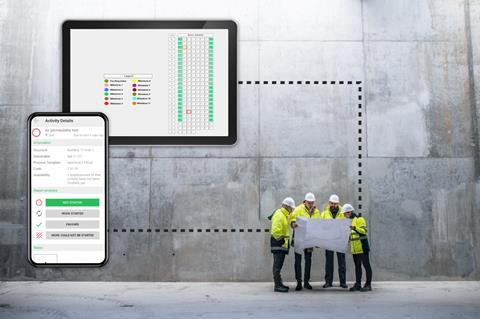Lukas Olbrich, chief executive of the construction project execution platform, Sablono, explains how to deliver accountability, transparency and compliance with the Building Safety Act on today’s large and complex construction projects
The Grenfell Tower tragedy has brought into focus issues which have long plagued the construction industry. Large building projects have complex supply and contractual chains, which make it difficult to pinpoint what work has been carried out, when and by who. In the years after construction is complete, it is not always possible to discover who bears responsibility for an issue should a problem arise.

A major strand in the government’s response has been The Building Safety Act, which received Royal assent in April 2022. A key element of the Act is the establishment of a “golden thread of information” to run through construction projects. The aim is to rectify the problems of the past and ensure that construction projects are more streamlined, with clearer chains of responsibility.
The thread will cover every facet of a building’s design and build and comprehensively explain its construction; safety design; maintenance, operation, and current condition; statutory compliance status; remedial actions carried out to rectify problems; and planned works. It will be available to view throughout the construction process, from design through build. Then, going forward, it will be available throughout the building’s life, too. Never again should we have a situation where it is unclear who is accountable for actions or decisions.
True accountability and on-site collaboration can only occur when progress tracking solutions provide structured data that allow you to clearly understand the chain of events that go into completing a project - not just a series of ‘snapshots’.
During the drafting of the legislation, the government held a consultation, which was published in April 2020. Most respondents were receptive to what the government wanted to achieve, but some were concerned about its feasibility. Just how could a golden thread be implemented with the current lack of digital skills and capacity in the sector? What of the inevitable complexity that implementation would entail? What would the cost implications be?
The government has recognised these challenges and therefore suggests the golden thread needs to be digital. This would make referring to it easier, especially in years to come when regulators and other interested parties wish to check on the health of a building.
Of course, the question which then needs to be asked is what do we mean by digital? As with all sectors, the digital revolution is changing the construction industry in radical ways and the pace of change shows no sign of let-up. Current innovations include cameras, robots and drones. All of this is helpful, and can improve on-site efficiencies and safety, but it doesn’t get to the heart of the golden thread. Even with this technology, there remains uncertainty around who did what, trades still complete tasks at the wrong time, and there is still no clear record of information.

Achieving the golden thread on projects lies in harnessing accurate progress information, and this is where progress tracking solutions can change things. This type of digital solution provides a holistic view of everything that takes place on the construction site, conveniently recorded in digital form. But it’s necessary to be aware that not all progress tracking solutions are created equal. Many rely on snapshot visual data which lack the ability to share information in real-time, while others only allow for a narrow set of activities tracked at any one time.
True accountability and on-site collaboration can only occur when progress tracking solutions provide structured data that allow you to clearly understand the chain of events that go into completing a project - not just a series of ‘snapshots’. A good solution will ensure that even the most granular level of project data is accessible in real-time to whoever needs it, whenever they want it.
As we look to the future, regulators will demand increasingly more accurate and detailed information about a building’s history, and so finding a solution that meets the above criteria to provide rich insights into the state of a project will soon be essential.
Sablono is an application which delivers and meets the requirements of the golden thread. As a ‘single source of truth’, it gives all parties greater accountability and transparency on projects to increase confidence around quality assurance and compliance with key legislation and regulations. It provides insights into invaluable data such as which subcontractor performed the work at what point in time? Was it signed-off? If so, by whom? This creates a fully accountable digital audit trail to ensure the golden thread of information.
![]()
Sablono is the world’s first construction execution platform specifically designed for large and complex construction projects and combines quality and progress-related information all in one system. It connects everyone and everything on-site, and so breaks down silos and encourages communication. This allows major and complex construction projects to become truly digital and thus easier to manage. Delays or defects in a project can be easily identified and managed, their wider impact understood and mitigated; the impact even the smallest change can have on a project can be predicted.
With Sablono everyone working on a project, and not just planners, is responsible for reporting their work. This fosters collaboration and ownership. Unlike other solutions on the market, Sablono offers a truly remarkable level of detail: hundreds of thousands of activities tracked on-site can be viewed in the easy-to-use app. This is important during design and construction and can boost efficiencies and savings. But going forward, it fulfils the promise of the golden thread, providing a digital audit trail to run through the life of the building and into the decades to come.
For more information visit: www.sablono.com




























No comments yet